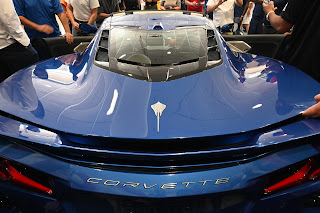Easy-Breazy T-Bird
In 1953 Chevrolet decided to compete with European automotive sport car manufacturers and introduce the Corvette. Rival Ford was not going to take the challenge lightly, so in 1955, they introduced a uniquely American answer, the Ford Thunderbird. While the first-generation Vette in ever-increasing performance and style was offered through the 1962 model year, the first-generation Ford T-Bird was only made for three years.
The press and the public loved the V8 power, sleek styling, and creature comforts of the Thunderbird and it became an instant classic, outselling the Corvette by 23 to 1. Like the Corvette, the 2nd year production of the Thunderbird featured upgrades such as 12V electrical, side vents to help cool the cabin, optional portals to reduce blind spots, and the Continental Kit that freed up space for golf clubs in the trunk.
Ford imagined their offering more as a Personal Luxury Car than a true sports car. Options such as power steering, power breaks, power-adjustable seats, and automatic transmission were geared toward the American driver rather than the austere European driver.
Today's feature is a 1956 example from the 2nd production year not heavily optioned, no portholes, larger V8, and automatic transmission. Many owners of classic cars that are not concourse examples, make a series of updates that make the car more of a "driver" and less of a show car.
These are softer upgrades that most classic car owners can make that add to drivability and reliability but do not detract from the original driving experience. This example has been fitted with a Holly 4-barrel carburetor, alternator, modern hydraulic power steering, more efficient cooling fan, upgrades to the heater controls, radial tiers, upgraded stereo, LED headlights, and electric wipers. Most casual observers will not notice the upgrades and see a '56 T-Bird.
The original power steering offering was assisted by a hydraulic piston linked to the steering linkage. This example features a hydraulic steering box from Borgeson. Many owners of classic cars looking for power-assisted steering solutions are opting for even more modern electric solutions. Electronic options are considered more efficient, easier to install, and can feature speed-sensitive assist.Early generators were often unreliable, large, and robbed power from the engine. Modern alternators have internal regulators, are less taxing on the engine, and are more reliable. While purists prefer the dynamo or generator, it is rare to see classic drivers retain this outdated, complex, and inefficient charging system.
This example is hardly reimagined or modified but does feature the most often upgraded components, fuel delivery, electrical charging, power assist steering, entertainment, and tires. It retains the goals and experience envisioned by Ford as a Personal Luxury Vehicle.





Comments
Post a Comment